COSPAR ID 2001-014A Max speed 21,270 km/h Launch date 7 April 2001 | SATCAT no. 26734 Launch mass 758 kg Cost 297 million USD | |
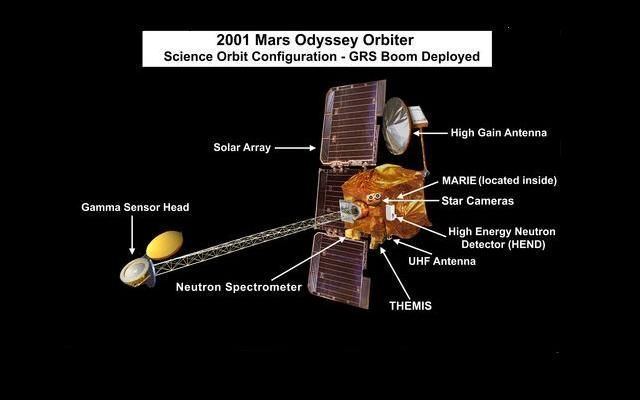 | ||
Website mars.jpl.nasa.gov/odyssey/ Mission duration Elapsed:15 years, 10 months and 15 days from launch15 years, 3 months and 29 days at Mars (5450 sols)En route: 6 months, 17 daysPrimary mission: 32 months (1007 sols)Extended mission: 12 years, 5 months and 28 days (4442 sols) elapsed Similar | ||
Aerobraking no tumble for redesigned safemode for the 2001 mars odyssey spacecraft
2001 Mars Odyssey is a robotic spacecraft orbiting the planet Mars. The project was developed by NASA, and contracted out to Lockheed Martin, with an expected cost for the entire mission of US$297 million. Its mission is to use spectrometers and a thermal imager to detect evidence of past or present water and ice, as well as study the planet's geology and radiation environment. It is hoped that the data Odyssey obtains will help answer the question of whether life has ever existed on Mars and create a risk-assessment of the radiation future astronauts on Mars might experience. It also acts as a relay for communications between the Mars Exploration Rovers, Mars Science Laboratory, and previously the Phoenix lander to Earth. The mission was named as a tribute to Arthur C. Clarke, evoking the name of 2001: A Space Odyssey.
Contents
- Aerobraking no tumble for redesigned safemode for the 2001 mars odyssey spacecraft
- Naming
- Scientific instruments
- Mission
- Water on Mars
- Odyssey and Curiosity
- References

Odyssey was launched April 7, 2001 on a Delta II rocket from Cape Canaveral Air Force Station, and reached Mars orbit on October 24, 2001, at 02:30 UTC (October 23, 19:30 PDT, 22:30 EDT). It is currently in a polar orbit around Mars with an altitude of about 3,800 km or 2,400 miles.
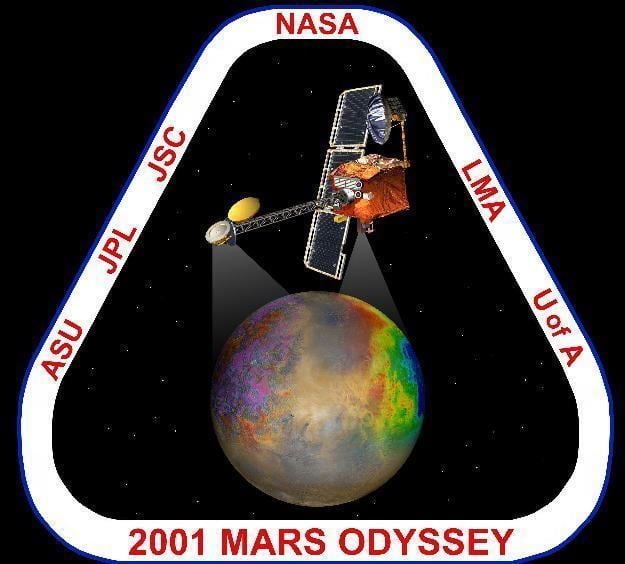
By December 15, 2010 it broke the record for longest serving spacecraft at Mars, with 3,340 days of operation, claiming the title from NASA's Mars Global Surveyor. It currently holds the record for the longest-surviving continually active spacecraft in orbit around a planet other than Earth, ahead of the Pioneer Venus Orbiter, at 15 years, 3 months and 29 days.
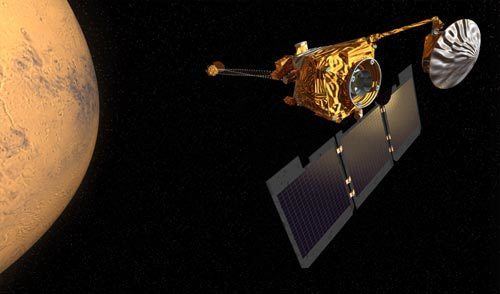
Naming
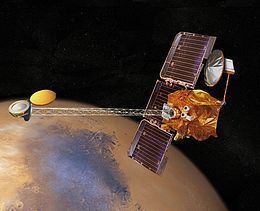
Mars Odyssey was originally a component of the Mars Surveyor 2001 program, and was named the Mars Surveyor 2001 Orbiter. It was intended to have a companion spacecraft known as Mars Surveyor 2001 Lander, but the lander mission was canceled in May 2000 following the failures of Mars Climate Orbiter and Mars Polar Lander in late 1999. Subsequently, the name 2001 Mars Odyssey was selected for the orbiter as a specific tribute to the vision of space exploration shown in works by Arthur C. Clarke, including 2001: A Space Odyssey. The music from Mythodea by Greek composer Vangelis was used as the theme music for the mission.
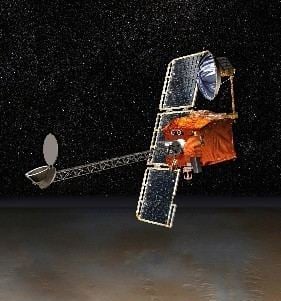
In August 2000, NASA solicited candidate names for the mission, which were evaluated by a naming committee consisting of Mark Dahl, Michael Meyer, Steve Saunders, and Don Savage. Out of 200 names submitted, the committee chose Astrobiological Reconnaissance and Elemental Surveyor, abbreviated ARES (a tribute to Ares, the Greek god of war). Faced with criticism that this name was not very compelling, and too aggressive, the naming committee reconvened. The candidate name "2001 Mars Odyssey" had earlier been rejected because of copyright and trademark concerns. However, NASA e-mailed Arthur C. Clarke in Sri Lanka, who responded that he would be delighted to have the mission named for his books, and he had no objections. On September 20, NASA associate administrator Ed Weiler wrote to the associate administrator for public affairs recommending a name change from ARES to 2001 Mars Odyssey. Peggy Wilhide then approved the name change.
Scientific instruments
The three primary instruments Odyssey uses are the:
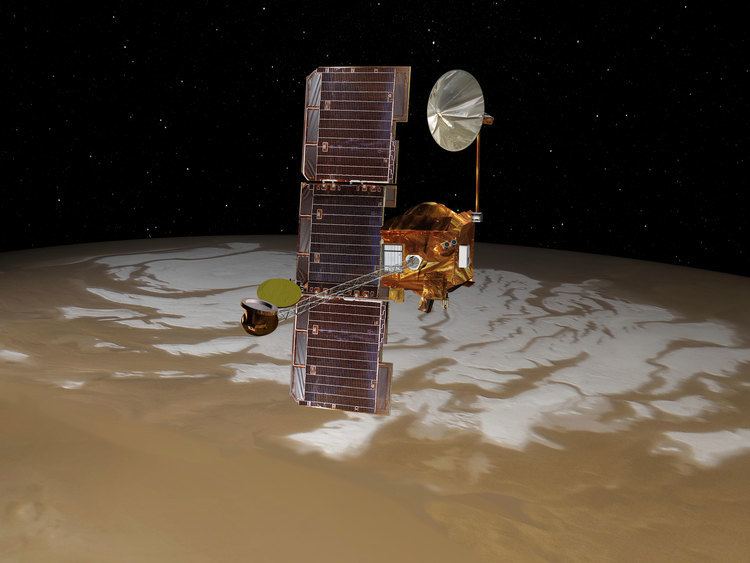
On May 28, 2002 (sol 210), NASA reported that Odyssey's GRS had detected large amounts of hydrogen, a sign that there must be ice lying within a meter of the planet's surface. GRS is a collaboration between University of Arizona's Lunar and Planetary Lab., the Los Alamos National Laboratory, and Russia's Space Research Institute.
Mission
Mars Odyssey launched from Cape Canaveral on April 11, 2001, and arrived at Mars about 200 days later on October 24. The spacecraft's main engine fired in order to brake the spacecraft's speed, which allowed it to be captured into orbit around Mars. Odyssey then spent about three months aerobraking, using friction with the upper reaches of the Martian atmosphere to gradually slow down and to shrink and circularize its orbit. By using the atmosphere of Mars to slow down the spacecraft in its orbit, rather than firing its engine or thrusters, Odyssey was able to save more than 200 kilograms (440 lb) of propellant. (This reduction in spacecraft weight allowed the mission to be launched on a Delta II 7925 launch vehicle, rather than a larger, more expensive launcher.) Aerobraking ended in January, and Odyssey began its science mapping mission on February 19, 2002. Odyssey's original, nominal mission lasted until August 2004, but repeated mission extensions have kept the mission active.
Odyssey has served as the primary means of communications for NASA’s Mars surface explorers in the past decade, up to the Curiosity rover. About 85% of images and other data from NASA's twin Mars Exploration Rovers, Spirit and Opportunity, have reached Earth via communications relay by Odyssey. Odyssey continues to receive transmissions from the surviving rover, Opportunity, every day. The orbiter helped analyze potential landing sites for the rovers and performed the same task for NASA's Phoenix mission, which landed on Mars in May 2008. Odyssey aided NASA's Mars Reconnaissance Orbiter, which reached Mars in March 2006, by monitoring atmospheric conditions during months when the newly arrived orbiter used aerobraking to alter its orbit into the desired shape.
Odyssey is in a sun-synchronous orbit, which provides consistent lighting for its photographs. On September 30, 2008 (sol 2465) the spacecraft altered its orbit to gain better sensitivity for its infrared mapping of Martian minerals. The new orbit eliminated the use of the gamma ray detector, due to the potential for overheating the instrument at the new orbit.
The payload's MARIE radiation experiment stopped taking measurements after a large solar event bombarded the Odyssey spacecraft on October 28, 2003. Engineers believe the most likely cause is that a computer chip was damaged by a solar particle smashing into the MARIE computer board.
One of the orbiter's three flywheels failed in June 2012. However, Odyssey's design included a fourth flywheel, a spare carried against exactly this eventuality. The spare was spun up and successfully brought into service. Since July 2012, Odyssey has been back in full, nominal operation mode following three weeks of 'safe' mode on remote maintenance.
In February 11, 2014, mission control accelerated Odyssey's drift toward a morning-daylight orbit to "enable observation of changing ground temperatures after sunrise and after sunset in thousands of places on Mars". The desired change will occur gradually until the intended orbit geometry is reached in November 2015 and another manoeuvre halts the drift. Those observations could yield insight about the composition of the ground and about temperature-driven processes, such as warm-season flows observed on some slopes, and geysers fed by spring thawing of carbon dioxide (CO2) ice near Mars' poles.
On October 19, 2014, NASA reported that the Mars Odyssey Orbiter, as well as the Mars Reconnaissance Orbiter and MAVEN, were healthy after the Comet Siding Spring flyby.
In 2010, a spokesman for NASA's Jet Propulsion Laboratory stated that Odyssey could continue operating until at least about 2016 and "perhaps even well beyond". This estimate has since been extended to "about ten more years" (until 2025).
Water on Mars
Mars Odyssey mapped the distribution of water in the surface. The ground truth for its measurements came on July 31, 2008, when NASA announced that the Phoenix lander confirmed the presence of water on Mars, as predicted in 2002 based on data from the Odyssey orbiter. The science team is trying to determine whether the water ice ever thaws enough to be available for microscopic life, and if carbon-containing chemicals and other raw materials for life are present.
Odyssey and Curiosity
Mars Odyssey's THEMIS instrument was used to help select a landing site for the Mars Science Laboratory (MSL). Several days before MSL's landing in August 2012, Odyssey's orbit was altered to ensure that it would be able to capture signals from the rover during its first few minutes on the Martian surface. Odyssey now acts as a relay for UHF radio signals from the (MSL) rover Curiosity. Because Odyssey is in a sun-synchronous orbit, it consistently passes over Curiosity's location at the same two times every day, allowing for convenient scheduling of contact with Earth.
